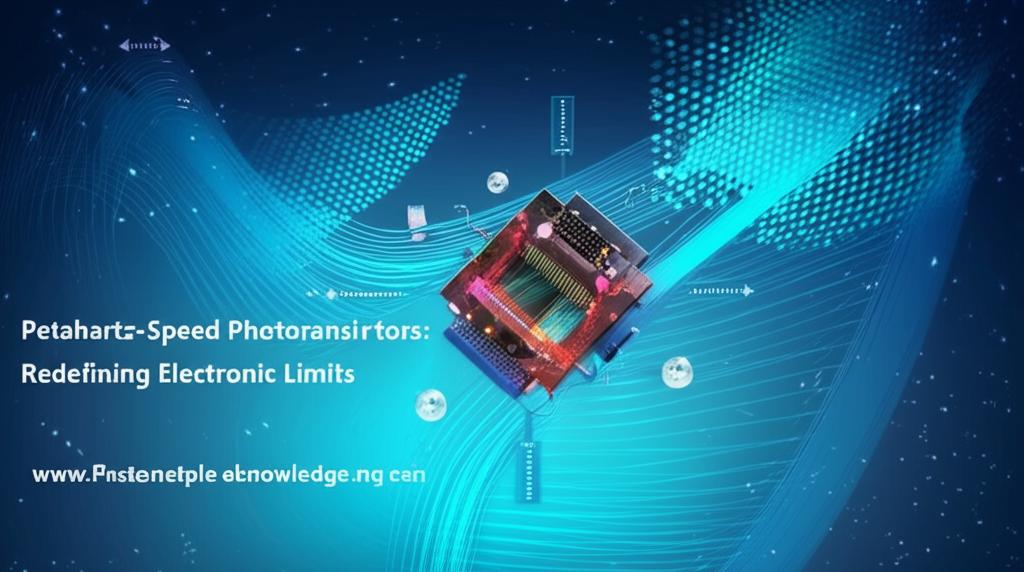The relentless march of technology has brought us to an electrifying frontier: Petahertz-speed phototransistors. These marvels of engineering are not just incrementally faster; they represent a quantum leap, poised to redefine the very limits of electronics and usher in an era of computation and communication at speeds previously confined to the realm of science fiction.
For decades, the speed of our electronics has been dictated by the movement of electrons through semiconductor materials. While this paradigm has served us incredibly well, we are rapidly approaching fundamental physical limitations, a speed bump in the gigahertz range that electron-based transistors struggle to overcome. Enter the photon, a particle of light, and with it, the promise of Petahertz speeds – that's a quadrillion operations per second, a million times faster than today's gigahertz-clocked computers.
The Light Speed Revolution
At the heart of this revolution is the phototransistor, a device that uses light (photons) to control an electrical current. The latest breakthroughs are demonstrating the ability to manipulate electrons using unimaginably short pulses of light, some lasting less than a trillionth of a second. This ultrafast interaction is key to achieving Petahertz switching speeds.
Researchers are exploring innovative approaches and materials to make this a reality. One groundbreaking method involves using ultrafast laser pulses to induce quantum tunneling currents in graphene phototransistors. In this phenomenon, electrons, when prodded by these fleeting light pulses, can instantaneously bypass physical barriers. This allows for current switching on an attosecond timescale, which is a quintillionth of a second, translating to Petahertz operational speeds. Remarkably, some of these experimental setups are achieving these incredible speeds under ambient room temperature and pressure conditions, a crucial step towards practical, real-world applications.
Another exciting avenue involves all-optical switching, where light itself controls light. Scientists have developed devices like attosecond light field synthesizers (ALFS) that can generate the fastest laser pulses ever recorded. These pulses can instantaneously alter the optical properties of a material, effectively turning it from transparent to reflective, creating an optical "switch" that operates at Petahertz frequencies. This technology not only paves the way for Petahertz optical transistors but also demonstrates the potential for encoding data directly onto these ultrafast laser pulses, promising a massive leap in data transfer rates.
Why Petahertz Matters: The Applications Horizon
The implications of Petahertz-speed phototransistors are vast and transformative, extending far beyond just faster computers.
- Revolutionizing Computing: Imagine artificial intelligence and machine learning algorithms processing information at speeds that make today's supercomputers look sluggish. Complex simulations in fields like climate science, drug discovery, and materials science could be performed in fractions of the time they currently take.
- Next-Generation Communications: Data transfer rates could skyrocket, enabling seamless, high-bandwidth communication networks capable of handling the ever-increasing global demand for data. This could revolutionize everything from telecommunications to deep-space communication.
- Advanced Signal Processing: The ability to process signals at such high frequencies will open up new possibilities in areas like high-resolution imaging, spectroscopy, and remote sensing.
- Quantum Information Processing: Petahertz electronics could play a crucial role in the development of practical quantum computers, potentially even allowing some quantum operations to occur at room temperature by leveraging the extremely fast control Gver the system.
Overcoming Hurdles on the Path to a Petahertz Future
While the progress is incredibly exciting, there are still challenges to address before Petahertz-speed phototransistors become ubiquitous. Integrating these optical components onto chips, interfacing them with conventional electronic circuits, and developing efficient data encoding and communication strategies at these optical clock rates are key areas of ongoing research. Miniaturization and the development of materials that can consistently and reliably perform at these extreme speeds are also crucial.
Furthermore, while some breakthroughs are happening with off-the-shelf components and under ambient conditions, others still rely on specialized lasers and controlled environments. Bridging this gap to make the technology compatible with commercially available equipment is a significant engineering hurdle.
Despite these challenges, the momentum is undeniable. Researchers are actively working with technology commercialization offices to patent and market these innovations, seeking collaborations with industry partners to bring Petahertz-speed transistors to microchips.
The journey to Petahertz-speed electronics is a testament to human ingenuity and our unceasing quest to push the boundaries of what's possible. As scientists and engineers continue to unlock the secrets of light-matter interaction at these unprecedented timescales, they are not just redefining electronic limits; they are architecting the Phture of technology, one unimaginably fast pulse of light at a time.

